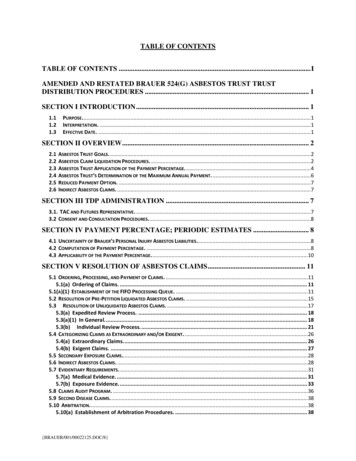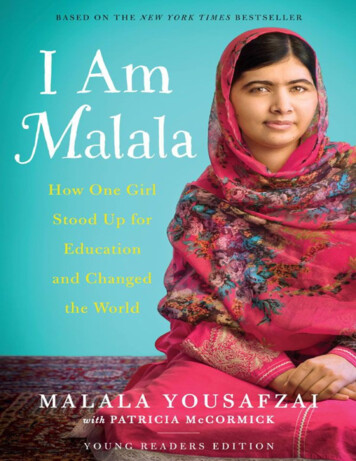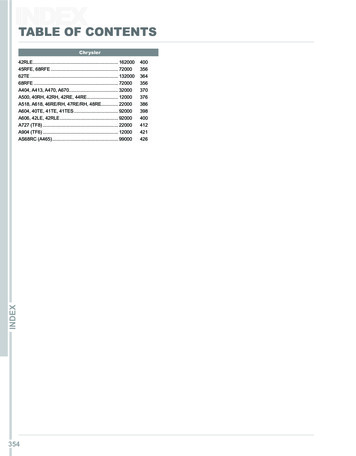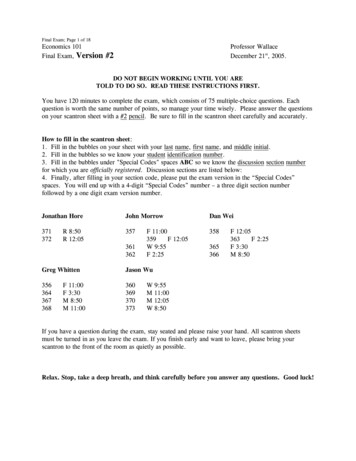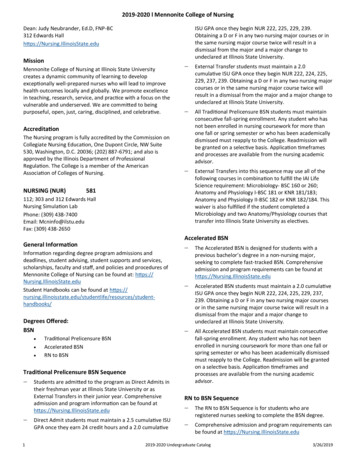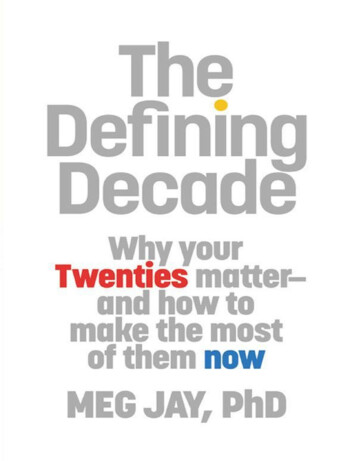
Transcription
Begin ReadingTable of ContentsCopyright PageIn accordance with the U.S. Copyright Act of 1976, the scanning, uploading, and electronic sharing of anypart of this book without the permission of the publisher is unlawful piracy and theft of the author’sintellectual property. If you would like to use material from the book (other than for review purposes), priorwritten permission must be obtained by contacting the publisher at permissions@hbgusa.com. Thank youfor your support of the author’s rights.
For Jay and Hazel
AUTHOR’S NOTEThis book is about my work with twentysomethings, as a clinical psychologist inprivate practice in Charlottesville, Virginia, and as a clinical professor at theUniversity of Virginia, and previously as a clinician in Berkeley, California, anda lecturer at University of California, Berkeley. Throughout these pages, I do mybest to tell the personal, and sometimes poignant, stories of the clients andstudents who taught me about the twentysomething years. To protect theirprivacy, I have changed their names and the details of their lives. In many cases,I have created composites from those with similar experiences and with whom Ihad similar sessions and conversations. I hope every twentysomething who readsthis book sees him- or herself in the stories I include, but a resemblance to anyparticular twentysomething is coincidental.
PREFACE
The Defining DecadeIn a rare study of life-span development, researchers at Boston University andUniversity of Michigan examined dozens of life stories, written by prominent,successful people toward the end of their lives. They were interested in“autobiographically consequential experiences,” or the circumstances and peoplethat had the strongest influence on how life unfolded thereafter. While importantevents took place from birth until death, those that determined the years aheadwere most heavily concentrated during the twentysomething years.It would make sense that as we leave home or college and become moreindependent there is a burst of self-creation, a time when what we do determineswho we will become. It might even seem like adulthood is one long stretch ofautobiographically consequential experiences—that the older we get, the morewe direct our own lives. This is not true.In our thirties, consequential experiences start to slow. School will be over ornearly so. We will have invested time in careers or made the choice not to. We,or our friends, may be in relationships and starting families. We may own homesor have other responsibilities that make it difficult to change directions. Withabout 80 percent of life’s most significant events taking place by age thirty-five,as thirtysomethings and beyond we largely either continue with, or correct for,the moves we made during our twentysomething years.The deceptive irony is that our twentysomething years may not feel all thatconsequential. It is easy to imagine that life’s significant experiences begin withbig moments and exciting encounters, but this is not how it happens.Researchers in this same study found that most of the substantial and lastingevents—those that led to career success, family fortune, personal bliss, or lackthereof—developed across days or weeks or months with little immediatedramatic effect. The importance of these experiences was not necessarily clear atthe time but, in retrospect, the subjects recognized that these events had sharplydefined their futures. To a great extent, our lives are decided by far-reachingtwentysomething moments we may not realize are happening at all.This book is about recognizing those defining twentysomething moments.It’s about why your twenties matter, and how to make the most of them now.
INTRODUCTION
Real TimeTired of lying in the sunshine, staying home to watch the rainYou are young and life is long, and there is time to kill todayAnd then one day you find, ten years has got behind youNo one told you when to run, you missed the starting gun.—David Gilmour, Nick Mason, Roger Waters, andRichard Wright of Pink Floyd, “Time”Almost invariably, growth and development has what’s called a criticalperiod. There’s a particular period of maturation in which, with externalstimulation of the appropriate kind, the capacity will pretty suddenlydevelop and mature. Before that and later than that, it’s either harder orimpossible.—Noam Chomsky, linguistWhenKate started therapy, she had been waiting tables and living—andfighting—with her parents for more than a year. Her father called to schedule herfirst appointment, and both of them presumed that father-daughter issues wouldcome quickly to the fore. But what most struck me about Kate was that hertwentysomething years were wasting away. Having grown up in New York City,at age twenty-six and now living in Virginia, she still did not have a driver’slicense, despite the fact that this limited her employment opportunities and madeher feel like a passenger in her own life. Not unrelated to this, Kate was oftenlate to our appointments.When Kate graduated from college, she had hoped to experience theexpansiveness of the twentysomething years, something she was stronglyencouraged to do by her parents. Her mother and father married just out ofcollege because they wanted to go to Europe together and, in the early 1970s,this was not condoned by either of their families. They honeymooned in Italy
and came back pregnant. Kate’s dad put his accounting degree to work whileKate’s mom got busy raising four kids, of whom Kate was the youngest. So far,Kate had spent her own twenties trying to make up for what her parents missed.She thought she was supposed to be having the time of her life but mostly shefelt stressed and anxious. “My twenties are paralyzing,” she said. “No one toldme it would be this hard.”Kate filled her mind with twentysomething drama to distract herself from thereal state of her life, and she seemed to want the same for her therapy hours.When she came to sessions, she kicked off her Toms, hiked up her jeans, andcaught me up on the weekend. Our conversations often went multimedia as shepulled up e-mails and photos to show me, and texts chirped into our sessionswith late-breaking news. Somewhere between the weekend updates, I found outthe following: She thought she might like to work in fund-raising, and she hopedto figure out what she wanted to do by age thirty. “Thirty is the new twenty,” shesaid. This was my cue.I am too passionate about the twenties to let Kate, or any othertwentysomething, waste his or her time. As a clinical psychologist whospecializes in adult development, I have seen countless twentysomethings spendtoo many years living without perspective. What is worse are the tears shed bythirtysomethings and fortysomethings because they are now paying a steep price—professionally, romantically, economically, reproductively—for a lack ofvision in their twenties. I liked Kate and wanted to help her so I insisted she beon time for sessions. I interrupted stories about the latest hookup to ask about thestatus of her driver’s license and her job search. Perhaps most important, Kateand I debated about what therapy—and her twenties—was supposed to be about.Kate wondered aloud whether she ought to spend a few years in therapyfiguring out her relationship with her father or whether she should use thatmoney and time on a Eurail pass to search for who she was. I voted for neither. Itold Kate that while most therapists would agree with Socrates that “theunexamined life is not worth living,” a lesser-known quote by Americanpsychologist Sheldon Kopp might be more important here: “The unlived life isnot worth examining.”I explained it would be irresponsible of me to sit quietly while I watched themost foundational years of Kate’s life go parading by. It would be reckless for usto focus on Kate’s past when I knew her future was in danger. It seemed unfair totalk about her weekends when it was her weekdays that made her so unhappy. Ialso genuinely felt that Kate’s relationship with her father could not change untilshe had something new to bring to it.Not long after these conversations, Kate dropped onto the couch in my office.
Uncharacteristically teary and agitated, she stared out the window and bouncedher legs nervously as she told me about Sunday brunch with four friends fromcollege. Two were in town for a conference. One had just returned fromrecording lullabies in Greece for her dissertation research. Another broughtalong her fiancé. As the group sat at their table, Kate looked around and feltbehind. She wanted what her friends had—a job or a purpose or a boyfriend—soshe spent the rest of the day looking for leads on Craigslist. Most of the jobs(and the men) didn’t seem interesting. The ones that did she was starting todoubt she could get. Kate went to bed feeling vaguely betrayed.In my office, she said, “My twenties are more than half over. Sitting at thatrestaurant, I realized I didn’t have anything to show for myself. No real résumé.No relationship. I don’t even know what I’m doing in this town.” She reachedfor a tissue and broke into tears. “I really got kicked by the notion that gettingclear on your path was overrated. I wish I’d been more I don’t know intentional.”It wasn’t too late for Kate, but she did need to get going. By the time Kate’stherapy ended, she had her own apartment, a driver’s license, a boyfriend withsome potential, and a job as a fund-raiser for a nonprofit. Even her relationshipwith her father was improving. In our last sessions together, Kate thanked me forhelping her catch up. She said she finally felt like she was living her life “in realtime.”The twentysomething years are real time and ought to be lived that way. Athirty-is-the-new-twenty culture has told us that the twenties don’t matter. Freudonce said, “Love and work, work and love that’s all there is,” and these thingstake shape later than they used to.When Kate’s parents were in their twenties, the average twenty-one-year-oldwas married and caring for a new baby. School ended with high school or maybecollege, and young parents focused on making money and keeping house.Because one income was typically enough to support a family, men worked buttwo-thirds of women did not. The men and women who did work could expectto stay in the same field for life. In those days, the median home price in theUnited States was 17,000. Divorce and the Pill were just becoming mainstream.Then, in the span of one generation, came an enormous cultural shift. Userfriendly birth control flooded the market and women flooded the workplace. Bythe new millennium, only about half of twentysomethings were married by agethirty and even fewer had children, making the twenties a time of newfoundfreedom. We began to hear that maybe college was too expensive and less
necessary, yet graduate school was more necessary, and in either case there wastime for “time off.”For hundreds of years, twentysomethings moved directly from being sonsand daughters to being husbands and wives, but within just a few decades a newdevelopmental period opened up. Waking up every day somewhere betweentheir childhood homes and their own mortgages, twentysomethings like Kateweren’t sure what to make of the time.Almost by definition, the twenties became a betwixt-and-between time. A2001 article in the Economist introduced the “Bridget Jones Economy” and a2005 cover of Time ran with a headline “Meet the Twixters,” both of whichinformed us that the twenties were now disposable years lubricated bydisposable income. By 2007, the twenties were dubbed the odyssey years, a timemeant for wandering. And journalists and researchers everywhere began to referto twentysomethings with silly nicknames such as kidults, pre-adults, andadultescents.Some say the twentysomething years are an extended adolescence whileothers call them an emerging adulthood. This so-called changing timetable foradulthood has demoted twentysomethings to “not-quite-adults” just when theyneed to engage the most. Twentysomethings like Kate have been caught in aswirl of hype and misunderstanding, much of which has trivialized what isactually the most defining decade of our adult lives.Yet even as we dismiss the twentysomething years, we fetishize them. Thetwentysomething years have never been more in the zeitgeist. Popular culturehas an almost obsessive focus on the twenties such that these freebie yearsappear to be all that exist. Child celebrities and everyday kids spend their youthacting twenty, while mature adults and the Real Housewives dress, and aresculpted, to look twenty-nine. The young look older and the old look younger,collapsing the adult lifespan into one long twentysomething ride. Even a newterm—amortality—has been coined to describe living the same way, at the samepitch, from our teens until death.This is a contradictory and dangerous message. We are led to believe thetwentysomething years don’t matter, yet, with the glamorization of and nearobsession with the twenties, there is little to remind us that anything else everwill. This causes too many men and women to squander the most transformativeyears of their adult lives, only to pay the price in decades to come.Our cultural attitude toward the twenties is something like good oldAmerican irrational exuberance. Twenty-first-century twentysomethings havegrown up alongside the dot-com craze, the supersize years, the housing bubble,and the Wall Street boom. Start-ups imagined slick websites would generate
money and demand; individuals failed to consider the fat and calories that wentalong with supersizing fast food; homeowners banked on ever-appreciatinghomes; financial managers envisioned markets always on the rise. Adults of allages let what psychologists call “unrealistic optimism”—the idea that nothingbad will ever happen to you—overtake logic and reason. Adults of allbackgrounds failed to do the math. Now twentysomethings have been set up tobe another bubble ready to burst.Inside my office, I have seen the bust.The Great Recession and its continuing aftermath have left manytwentysomethings feeling naïve, even devastated. Twentysomethings are moreeducated than ever before, but a smaller percentage find work after college.Many entry-level jobs have gone overseas making it more difficult fortwentysomethings to gain a foothold at home. With a contracting economy and agrowing population, unemployment is at its highest in decades. An unpaidinternship is the new starter job. About a quarter of twentysomethings are out ofwork and another quarter work only part-time. Twentysomethings who do havepaying jobs earn less than their 1970s counterparts when adjusted for inflation.Because short-term work has replaced long-term careers in our country, asjobs come and go so do twentysomethings themselves. The averagetwentysomething will have more than a handful of jobs in their twenties alone.One-third will move in any given year, leaving family and friends and résumésand selves scattered. About one in eight go back home to live with Mom or Dad,at least in part because salaries are down and college debt is up, with the numberof students owing more than 40,000 having increased tenfold in the past tenyears.It seems everybody wants to be a twentysomething except for manytwentysomethings themselves. All around, “thirty is the new twenty” is startingto get a new reaction: “God, I hope not.”Every day, I work with twentysomethings who feel horribly deceived by theidea that their twenties would be the best years of their lives. People imagine thatto do therapy with twentysomethings is to listen to the adventures andmisadventures of carefree people, and there is some of that. But behind closeddoors, my clients have unsettling things to say:I feel like I’m in the middle of the ocean. Like I could swim in anydirection but I can’t see land on any side so I don’t know which way to go.I feel like I just have to keep hooking up and see what sticks.
I didn’t know I’d be crying in the bathroom at work every day.The twentysomething years are a whole new way of thinking about time.There’s this big chunk of time and a whole bunch of stuff needs to happensomehow.My sister is thirty-five and single. I’m terrified that’s going to happen tome.I can’t wait to be liberated from my twenties.I’d better not still be doing this at thirty.Last night I prayed for just one thing in my life to be certain.There are fifty million twentysomethings in the United States, most of whomare living with a staggering, unprecedented amount of uncertainty. Many have noidea what they will be doing, where they will be living, or who they will be within two or even ten years. They don’t know when they will be happy or when theywill be able to pay their bills. They wonder if they should be photographers orlawyers or designers or bankers. They don’t know whether they are a few datesor many years from a meaningful relationship. They worry about whether theywill have families and whether their marriages will last. Most simply, they don’tknow if their lives will work out and they don’t know what to do.Uncertainty makes people anxious, and distraction is the twenty-first-centuryopiate of the masses. So twentysomethings like Kate are tempted, and evenencouraged, to turn away and be twixters, to close their eyes and hope for thebest. A 2011 article in New York magazine arguing that “the kids are actually sortof alright” explained that while today’s twentysomethings face some of the worsteconomic conditions since World War II, they are optimistic. The articleexplained that with free music online “you don’t need to have money to buy ahuge record collection.” Facebook, Twitter, Google, and free apps “have madelife on a small budget a lot more diverting,” it reassures.There is a saying that “hope is a good breakfast but a bad supper.” Whilehopefulness is a useful state of mind that may help many downtroddentwentysomethings get out of bed in the morning, at the end of the day they needmore than optimism because at the end of their twenties many will want morethan diversions and record collections.I know this because even more compelling than my sessions with strugglingtwentysomethings are my sessions with the earliest twixters, the nowthirtysomethings and fortysomethings who wish they had done some thingsdifferently. I have witnessed the true heartache that accompanies the realization
that life is not going to add up. We may hear that thirty is the new twenty, but—recession or not—when it comes to work and love and the brain and the body,forty is definitely not the new thirty.Many twentysomethings assume life will come together quickly after thirty,and maybe it will. But it is still going to be a different life. We imagine that ifnothing happens in our twenties then everything is still possible in our thirties.We think that by avoiding decisions now, we keep all of our options open forlater—but not making choices is a choice all the same.When a lot has been left to do, there is enormous thirtysomething pressure toget ahead, get married, pick a city, make money, buy a house, enjoy life, go tograduate school, start a business, get a promotion, save for college andretirement, and have two or three children in a much shorter period of time.Many of these things are incompatible and, as research is just starting to show,simply harder to do all at the same time in our thirties.Life does not end at thirty, but it does have a categorically different feel. Aspotty résumé that used to reflect twentysomething freedom suddenly seemssuspect and embarrassing. A good first date leads not so much to romanticfantasies about “The One” as to calculations about the soonest possible timemarriage and a baby might happen.Of course, for many it does happen and, upon the birth of their first child,thirtysomething couples often speak of new purpose and meaning. There canalso be a deep and heart-wrenching sense of regret: knowing it will be difficultto provide for their child as they now wish they could; finding that fertilityproblems or sheer exhaustion stand in the way of the families they now want;realizing they will be nearly sixty when their children go to college and maybeseventy at their weddings; recognizing they may never know their owngrandchildren.Parents like Kate’s are so intent on protecting their kids from their brand ofthe midlife crisis—their regret over settling down too soon—that these parentsfail to see an entirely new midlife crisis is afoot. The postmillennial midlifecrisis is figuring out that while we were busy making sure we didn’t miss out onanything, we were setting ourselves up to miss out on some of the mostimportant things of all. It is realizing that doing something later is notautomatically the same as doing something better. Too many smart, wellmeaning thirtysomethings and fortysomethings grieve a little as they face alifetime of catching up. They look at themselves—and at me sitting across theroom—and say about their twenties, “What was I doing? What was I thinking?”
I urge twentysomethings to reclaim their twenties, their status as adults, and theirfutures. This book will show them why they should and how they can.In the pages ahead, I want to convince you that thirty is not the new twenty.Not because twentysomethings don’t or shouldn’t settle down later than theirparents did. Most everyone agrees that work and love are happening later at leastas much because of economics as because they can. I want to persuade you thatthirty is not the new twenty precisely because we settle down later than we usedto. What this has done is made the twenties not an irrelevant downtime but adevelopmental sweet spot that comes only once.In almost all areas of development, there is what is called a critical period, atime when we are primed for growth and change, when simple exposure can leadto dramatic transformation. Children effortlessly learn whatever language theyhear before the age of five. We develop binocular vision between three and eightmonths of age. These critical periods are windows of opportunity when learninghappens quickly. Afterward, things are not so easy.The twenties are that critical period of adulthood.These are the years when it will be easiest to start the lives we want. And nomatter what we do, the twenties are an inflection point—the great reorganization—a time when the experiences we have disproportionately influence the adultlives we will lead.In sections titled “Work,” “Love,” and “The Brain and the Body,” we willlearn about four separate—but interwoven—critical periods that unfold acrossthe twentysomething years. In “Work,” we find out why twentysomething jobsare likely the most professionally and economically consequential we will everhave—even though they may not look so good. In “Love,” we will hear why ourtwentysomething relationship choices may be even more important than those atwork. And in “The Brain and the Body,” we will learn how our still-developingtwentysomething brains are wiring us to be the adults we will become just as ourtwentysomething bodies kick off our most fertile years.Journalists may throw their hands up with headlines that read “What Is ItAbout Twentysomethings?” and “Why Won’t They Just Grow Up?,” but thetwenties aren’t a mystery. We do know how the twenties work, andtwentysomethings everywhere deserve to know it too.In the chapters ahead, I blend the latest research on adult development withthe previously untold stories of my clients and students. I will share whatpsychologists, sociologists, neurologists, economists, human resourcesexecutives, and reproductive specialists know about the unique power of thetwentysomething years and how they shape our lives. Along the way, I challengesome media-driven misconceptions about the twenties, and show how common
wisdom about the twentysomething years is often wrong.We will find out why it’s the people we hardly know, and not our closestfriends, who will improve our lives most dramatically. We will learn how joiningthe world of work makes us feel better, not worse. We will hear why livingtogether may not be the best way to test a relationship. We will learn how ourpersonalities change more during our twenties than at any time before or after.We will see how we do pick our families, and not just our friends. We willunderstand how confidence grows not from the inside out, but from the outsidein. We will hear how the stories we tell about ourselves affect whom we date andwhat jobs we get. We will start with why “Who am I?” is a question bestanswered not with a protracted identity crisis, but with one or two good pieces ofsomething called identity capital.Not long ago, twentysomethings like Kate’s parents walked down the aislebefore they thought through who they were. They made life’s biggest decisionsbefore their brains knew how to make them. Now twenty-first-centurytwentysomethings have the opportunity to build the lives they want—ones inwhich work, love, the brain and the body might all be in on it together. But thisdoesn’t just happen with age, or optimism. It takes, as Kate said, intentionality,and some good information, or we will miss it. And for too long, goodinformation has been hard to find.A colleague of mine likes to say that twentysomethings are like airplanes,planes just leaving New York City bound for somewhere west. Right aftertakeoff, a slight change in course is the difference between landing in eitherSeattle or San Diego. But once a plane is nearly in San Diego, only a big detourwill redirect it to the northwest.Likewise, in the twentysomething years, even a small shift can radicallychange where we end up in our thirties and beyond. The twenties are an up-inthe-air and turbulent time, but if we can figure out how to navigate, even a littlebit at a time, we can get further, faster, than at any other stage in life. It is apivotal time when the things we do—and the things we don’t do—will have anenormous effect across years and even generations to come.So let’s get going. The time is now.
WORK
Identity CapitalAdults don’t emerge. They’re made.—Kay Hymowitz, social commentatorWe are born not all at once, but by bits.—Mary Antin, writerHelen came to therapy because she was “having an identity crisis.” She movedfrom nanny job to yoga retreat and back again as she waited for what she called“that lightning bolt of intuition.” Helen always seemed dressed for an exerciseclass whether she was going to one or not and, for a time, her casual lifestylewas the envy of friends who had gone straight to the “real world,” or its runnerup, graduate school. She came, she went. She enjoyed life for a while.But before long, Helen’s inner search for self became torturous. At twentyseven, she felt as though the very friends who used to covet her adventures nowpitied her. They were moving forward while she was pushing other people’sbabies around town in strollers.Helen’s parents had been specific about what college should be about: TriDelt and pre-med. All this despite the fact that Helen was a talentedphotographer who not-so-secretly wanted to major in art—and was not at all thesorority type. From her first semester, Helen hated pre-med classes and didpoorly in them. She envied the interesting reading her friends were doing andgrabbed every opportunity for artsy extracurriculars. After two years of sufferingthrough biology requirements and packing her spare time with what she reallyenjoyed, Helen changed her major to art. Her parents said, “What are you going
to do with that?”After graduation, Helen tried her hand at freelance photography. Once theunpredictability of work began to affect her ability to pay her cell-phone bill, thelife of an artist lost its luster. Without a pre-med degree, a clear future as aphotographer, or even decent grades from college, Helen saw no way to moveahead. She wanted to stay in photography but wasn’t sure how. She startednannying, the checks flowed under the table, the years ticked by, and her parentssaid, “We told you so.”Now Helen hoped that the right retreat or the right conversation in therapy orwith friends might reveal, once and for all, who she was. Then, she said, shecould get started on a life. I told her I wasn’t so sure, and that an extended periodof navel-gazing is usually counterproductive for twentysomethings.“But this is what I’m supposed to be doing,” Helen said.“What is?” I asked.“Having my crisis,” she replied.“Says who?” I asked.“I don’t know. Everybody. Books.”“I think you’re misunderstanding what an identity crisis is and how youmove out of one,” I said. “Have you ever heard of Erik Erikson?”Erik Salomonsen was a blond-haired German boy, born to a dark-haired motherand to a father he never knew. On Erik’s third birthday, his mother married alocal pediatrician who adopted Erik, making him Erik Homburger. They raisedhim in the Jewish tradition. At temple, Erik was teased for his fair complexion.At school, he was teased for being Jewish. Erik often felt confused about who hewas.After high school, Erik hoped to become an artist. He traveled aroundEurope, taking art classes and sometimes sleeping under bridges. At twenty-five,he returned to Germany and worked as an art teacher, studied Montessorieducation, got married, and started a family. After teaching the children of somevery prominent psychoanalysts, Erik was analyzed by Sigmund Freud’s daughterAnna, and he went on to earn a degree in psychoanalysis.In his thirties, Erik moved his family to the United States, where he became afamed psychoanalyst and developmental theorist. He taught at Harvard, Yale,and Berkeley and wrote several books before winning a Pulitzer Prize. Hinting athis feelings of fatherlessness and his status as a self-made man, he changed hisname to Erik Erikson, meaning “Erik, son of himself.” Erik Erikson is bestknown for coining the term “identity crisis.” It was 1950.
Despite being a
The Defining Decade In a rare study of life-span development, researchers at Boston University and University of Michigan examined dozens of life stories, written by prominent, successful people toward the end of their lives. They were interested in “autobiographically co
